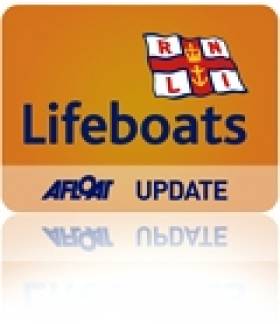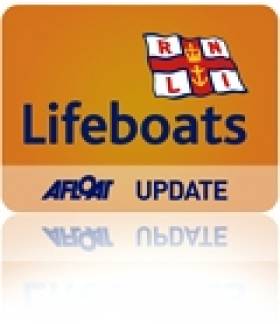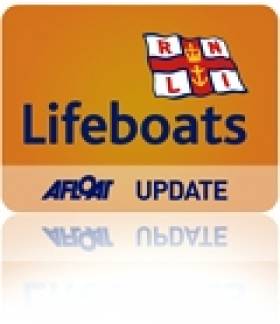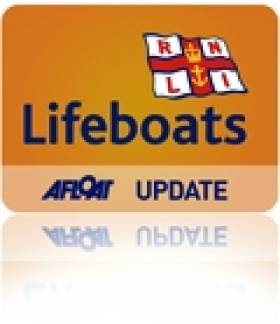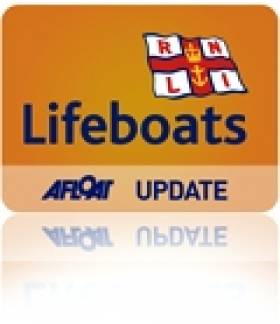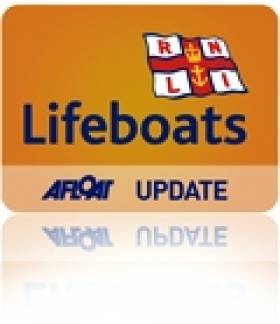Displaying items by tag: RNLI
Hot Tub Adrift In English Channel, Vessels Warned
#HotTub - Vessels in the English Channel have been warned to keep watch for a hot tub adrift in the water after a houseboat sank near Brighton this week.
On Wednesday 17 June, Newhaven RNLI attended to a tug towing two 22-metre houseboats on their way to the Thames area, one of which began taking on water and sank within 20 minutes.
As YBW reports, the lifeboat and tug crew were able to collect some debris that floated to the surface from the sunken houseboat.
But the hot tub was too large to recover, and its last known position was passed to Dover Coastguard.
#lifeboat – In the early hours of this morning Lough Swilly RNLI rescued three fishermen who had been reported missing after they failed to return home. It was the first rescue for Lough Swilly RNLI's new Shannon class lifeboat and her volunteer crew.
The callout occurred after the three fishermen from the Malin area took out a small fishing boat to test the engine just after 7.30pm last night. The alarm was raised before midnight when they had not returned and had failed to make contact with anyone on shore.
In a major search operation Malin Head Coast Guard requested Lough Swilly RNLI to launch both the Shannon class lifeboat and the inshore Atlantic lifeboat, along with the Portrush RNLI all-weather lifeboat and the Greencastle Coast Guard shore based unit. The groups were also joined by a large contingent of local fishing vessels from the Malin and Glengad area.
Conditions were described as choppy when at 2.30am the missing fishermen managed to make a call and give an approximate location. Lough Swilly RNLI's Shannon class lifeboat then picked up a small spot on their radar and headed for the area with large searchlights trained on the water. They located the men safe and well and wearing survival suits and lifejackets. The vessel has lost power and had drifted 12 miles.
Commenting on the callout John McCarter Lough Swilly RNLI Lifeboat Operations Manager said, 'You fear the worst when you hear fishermen are missing and we have seen too many tragedies in this part of the world. However the men kept their heads and were in proper survival gear which gave them every chance if something happened. The outpouring of support from the local fishing community was wonderful and bringing the vessel home under tow behind the lifeboat, to be greeted by locals lining the pier at that early hour of the morning was an incredible sight.
In this first rescue for our new Shannon class lifeboat, the time it took for us to reach the search area has been reduced on what our previous lifeboat could achieve, which in search and rescue operations can mean the difference between a life saved or a life lost.'
#lifeboat – The Courtmacsherry RNLI All Weather Lifeboat under Coxswain Sean O Farrell was called out at 7.10 pm yesterday evening to answer a distress call from a yacht that was reported in difficulties off the West Cork Coast, as it's single female sailor onboard had reported a brief message that she was in trouble writes Vincent Donovan. The Courtmacsherry Lifeboat with a crew of seven were away immediately and proceeded to carry out a search of the area along with the Baltimore RNLI Lifeboat and the Coastguard Helicopter Rescue 117.
The Casuality was located in difficulties 10 miles south of the Old Head of Kinsale and The Courtmacsherry Lifeboat took the yacht in tow and has now arrived back to the safe surrounds of Courtmacsherry Pier.
The yacht was taking part in a race from Falmouth, England to Baltimore when she lost steering and power. Conditions at sea today were windy force 5/6. The relieved skipper from Plymouth was glad to be on land tonight after a tiring four day journey in challenging conditions.
It was the second Callout of the evening for the Courtmacsherry crew as it was called out earlier at 6pm today to go to the aid of a 40 ft pleasure fishing boat that encountered difficulties off the Seven Heads in Courtmacsherry Bay. The Lifeboat had just towed the fishing boat back to Courtmacsherry Pier when the second Callout came from Valentia Coastguard. The Station's Voluntary Lifeboat Operations Manager Brian O Dywer was loud in his praise of the Lifeboat crew this evening and commented that ' it was a great example of Lifeboats and The Coastguard Helicopter acting quickly to locate the stricken Yacht and carry out an important rescue'
Wexford Lifeboats Assist Two After Yacht Breakdown
#RNLI - Volunteer lifeboat crew from Wexford and Rosslare Harbour RNLI launched on Sunday (14 June) to go to the assistance of two people onboard a 37ft yacht which got into difficulty off Wexford’s east coast.
Wexford RNLI launched their inshore lifeboat first at 4.30pm following reports that a yacht had suffered engine failure two miles south west of Raven’s Point. They then requested the assistance of their colleagues at Rosslare Harbour RNLI who subsequently launched their all-weather lifeboat.
Weather conditions at the time were described as good with a Force 5-6 northerly wind blowing. The sea was calm and there was good visibility.
The Wexford lifeboat, helmed by Lorraine Galvin and with crew members Simon Gulliver and Martin Conway onboard, arrived on scene at 5pm. Gulliver, who is also Wexford RNLI’s station mechanic, boarded the yacht and assessed the situation.
After inspection, Gulliver was able to get the fuel system working again and ran the boat for 10 minutes to ensure the vessel was operating smoothly. Rosslare Harbour RNLI stood by meanwhile, ready to assist if required. Following the checks, the yacht was able to continue on its journey.
Speaking following the callout, Galvin said: "We were delighted to be able to assist the two people who got into difficulty on their yacht today.
"Simon’s skills as mechanic paid off as he successfully managed to get the yacht back underway and in doing so avoided a lengthy tow back to shore."
Crosshaven Lifeboat Rescues Teens From Homemade Raft
#RNLI - Six teenagers have been rescued by Crosshaven RNLI this morning (Tuesday 16 June) after a member of the public spotted them in the water and raised the alarm.
The volunteer lifeboat crew was requested to launch their inshore lifeboat at 6.10am following a report from the Irish Coast Guard that six teenagers, three male and three female, were on a homemade raft half a mile east of Crosshaven.
Weather conditions at the time were described as good but the tide was changing and going out rapidly.
The lifeboat, helmed by Gary Heslin and with crew members Vincent Fleming and Aoife Dinan onboard, was launched at 6.15am and was on scene three minutes later. The crew observed five teenagers on the raft while another was in the water trying to pull the raft ashore using a rope.
The crew proceeded to take the six – one of whom was cold – onboard the lifeboat and transport them safely back to Crosshaven Harbour where they were made comfortable in the lifeboat station.
"Time was of the essence this morning and we have to thank the vigilant member of the public who spotted the group and raised the alarm," said Heslin after the callout.
"While weather conditions were good the tide was starting to turn pretty fast and was pushing the group out to sea. Thankfully, all are now returned to shore and are safe and well.
"We would encourage anyone taking to the water this summer to always be mindful of tides and weather conditions and always carry a means of communications in case you find yourself in any difficulty."
Yacht Aground on Lough Derg, Lifeboat Wades to the Rescue
Lough Derg RNLI Lifeboat launched to assist 4 people on board a 24ft yacht, aground in Sandy Bottom in Dromineer Bay last night.
At 8.03pm, Valentia Coast Guard requested Lough Derg RNLI Lifeboat to launch to assist four people on board a 24ft yacht, aground in Sandy Bottom, in Dromineer Bay.
The lifeboat launched at 8.12pm with helm Eleanor Hooker, Owen Cavanagh and Dean O'Sullivan on board. Winds were south westerly, Force 3, visibility was good.
The lifeboat located the cruiser at 8.13pm. Local boat owners had attempted to offer assistance, but found themselves in danger of grounding.
An RNLI volunteer waded in to the yacht, aground in two foot of water. He found that the four people on board were safe and unharmed. Once he established that vessel was not taking on water, he set up a bridle, and the lifeboat took the yacht under tow to Dromineer Harbour.
Brendan O'Brien, Deputy Launching Authority, advises all boat users to note that 'water levels on the lake are particularly low at the moment and to bear this in mind when passage planning'. He also suggests asking locals for advice if uncertain.
The Lifeboat returned to station and was ready for service again at 9.20pm.
#RNLI - Arklow RNLI’s volunteer lifeboat crew were alerted by pager at 6.44pm yesterday evening (14 June) to a call for help from a local fishing vessel in the station's second callout of the week, following the lifeboat's midweek rescue of a stricken sailboat.
The crew consisting of coxswain Ned Dillon, station mechanic Michael Fitzgerald, John Bermingham, Scotty Heaney, Keith Forde and Eddie McElheron launched the lifeboat Ger Tigchleaar and proceeded to the vessel, which had suffered machinery failure and was adrift outside the mouth of Arklow Harbour.
After locating the casualty vessel, the lifeboat crew established a tow line and proceeded back in to Arklow with the vessel alongside. All crew members aboard the casualty remained aboard during the service and all hands came ashore safely.
Speaking following the incident, Arklow RNLI volunteer lifeboat press officer Mark Corcoran said: "All people who take to the water whether for a living or for pleasure must always wear their lifejackets and should always have a means of raising the alarm."
Elsewhere, RNLI volunteers aboard Donaghadee's all-weather lifeboat Saxon sped to the rescue of a stricken vessel as darkness fell on Friday evening (12 June).
The 10-metre craft with a crew of one developed engine trouble on a passage to Westport in Co Mayo and was adrift in the busy sea lanes at the mouth of Belfast Lough.
The Donaghadee lifeboat launched at the request of the coastguard at 10.15pm and conducted a search in the gathering gloom one mile north of the Copeland Islands until the vessel was located.
In light sea conditions, a member of the RNLI crew boarded the vessel to assist with repairs and the lifeboat then escorted it to the safety of Bangor Marina. Saxon was back on station and stood down shortly after midnight.
Donaghadee RNLI coxswain Philip McNamara advised all boat owners "to conduct a thorough check of their engines, communications and safety equipment before putting to sea.
"If you encounter a problem, call for assistance at the earliest opportunity. We are ready to be of service and It is always better to be safe than sorry."
#rnli – Lifeboat crew with Union Hall RNLI had their third callout in a week when launched on Saturday afternoon (13 June 2015) to bring a 44–ft yacht with two crew onboard to safety after it reported engine problems off Galley Head.
The crew onboard the yacht raised the alarm with Valentia Coast Guard after they realised they were expiring severe engine trouble and they feared they would not be able to bring the vessel to safety. The Union Hall lifeboat was launched at 4.44pm and was on scene in thirty minutes.
Conditions were overcast with an easterly wind when the lifeboat took the yacht under tow into Glandore Harbour and ensured the two men were safely ashore.
Commenting on the callout Union Hall RNLI Deputy Launching Authority Peter Deasy said, 'It's been a busy week for the volunteer lifeboat crew with three callouts. Thankfully everyone was safe. Engine problems can happen to anyone and it is always advisable to call for assistance. The crew of the yacht were concerned that they would have difficulty making it safety to shore alone. The weather was not ideal in this case and they made the right call.
Yesterday's callout follows on from two incidents earlier in the week when the Union Hall RNLI crew launched following reports that a paddle boarder had disappeared from view and before that when an 18ft pleasure boat got into difficulty off the coast of West Cork.
#RNLI - Dunmore East RNLI is holding a 'blessing of the boats' ceremony and lifeboat open day in Dunmore East harbour next Sunday 21 June at 2pm.
The Dunmore East RNLI all-weather lifeboat will position in the harbour for the ceremony, and all seagoing vessels are welcome to come alongside for the duration.
The flotilla of boats will then head to sea, just outside the harbour wall, where the Dunmore East lifeboat crew will lay a wreath to remember those lost at sea.
At 3pm the Dunmore East Lifeboat will be joined by the Irish Coast Guard helicopter Rescue 117 for a winching demonstration. On return to the harbour, the lifeboat and station house – and lifeboat shop – will be open to the public.
The crew of Dunmore East RNLI are also having a BBQ at the station house afterwards, and welcome everyone to come and join them for a burger and light refreshments complements of the crew, along with music by the Matt Tappers and lots of fun with net mending and splicing competitions open to all.
"The blessing of the boats is a great tradition in Dunmore East and we hope that the fishermen, sailors and all seagoers will join our flotilla to remember those lost at sea," says Dunmore East RNLI's Neville Murphy.
"Our boat will be open to the public, so it a great chance for everyone to get a look inside an all-weather Trent class lifeboat and meet the crew who will answer all your questions.
"Our open day is our way of saying thank you to those who support us in our mission to save lives at sea."
Arklow Lifeboat In Midweek Callout To Sailboat In Difficulty
#RNLI - Arklow RNLI came to the assistance of a sailing vessel with sail damage and mechanical failure on Wednesday evening (10 June).
Following a planned exercise, Arklow lifeboat Ger Tigchlearr and its volunteer crew of Eamonn Kavanagh, John Berminghham, Michael Fitzgerald, Jimmy Myler and Trevor Conroy were returning to station around 8.30pm when a distress call was received from the vessel, about one mile south-east of Arklow Harbour.
The lifeboat crew proceeded to the location and took the vessel under tow back to Arklow, where all hands came ashore safely.
Following the rescue, Arklow RNLI sea safety officer Mark Corcoran said: "All skippers of vessels going to sea for work or pleasure should carry a means of calling for help and wear lifejackets.
"Calling for help in good time will lessen the chances of people ending up in the water and increase the chances of successful rescue."































